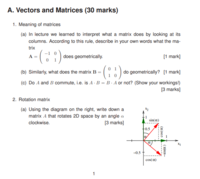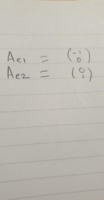You are using an out of date browser. It may not display this or other websites correctly.
You should upgrade or use an alternative browser.
You should upgrade or use an alternative browser.
Matrix rotations
- Thread starter Rano1234
- Start date
D
Deleted member 4993
Guest
Where is... what is 2a.Hi so I've been doing matrices recently to revise for an exam, I'm stuck on 2a and have no clue how to approach it, the question is This any help is appreciated Thanks.
In addition:
Please follow the rules of posting in this forum, as enunciated at:
READ BEFORE POSTING
Please share your work/thoughts about this assignment
D
Deleted member 4993
Guest
Please tell us the "rule" discussed in your class (that these problems are referring to).View attachment 15333here is the worksheet, i don't really have much working out as im not sure how to attempt it
D
Deleted member 4993
Guest
Please STATE the "rule" discussed in your class (that these problems are referring to).The rule simply states how a matrice is plotted onto a graph however it isnt needed for question 2a
Steven G
Elite Member
- Joined
- Dec 30, 2014
- Messages
- 14,603
I have a question about 1a.
I understand if we want to know what A does to a vector X, then we compute AX
But if what is being asked is what does A do to a matrix B (assume sizes are ok) do we compute AB or BA?
Or am I right that this needs to be given (and probably was in lecture class)?
I understand if we want to know what A does to a vector X, then we compute AX
But if what is being asked is what does A do to a matrix B (assume sizes are ok) do we compute AB or BA?
Or am I right that this needs to be given (and probably was in lecture class)?
pka
Elite Member
- Joined
- Jan 29, 2005
- Messages
- 11,978
The standard rotation matrix \(\displaystyle \mathscr{R}(\alpha)=\left( {\begin{array}{*{20}{c}} {\cos (\alpha )}&{\sin (\alpha )} \\ { - \sin (\alpha )}&{\cos (\alpha )} \end{array}} \right)\) is a rotation counter clockwise about the origin\(\displaystyle .\)View attachment 15333here is the worksheet, i don't really have much working out as im not sure how to attempt it
To get a clockwise rotation use \(\displaystyle \mathscr{R}(-\alpha)=\left( {\begin{array}{*{20}{c}} {\cos (\alpha )}&{-\sin (\alpha )} \\ { \sin (\alpha )}&{\cos (\alpha )} \end{array}} \right)\) note the LaTeX encoding is messed up.
LCKurtz
Full Member
- Joined
- May 3, 2019
- Messages
- 475
Does the rule tell you the connection between the entries in [MATH]A[/MATH] and what [MATH]A[/MATH] transforms the matrices [MATH]\begin{bmatrix} 1 \\ 0 \end{bmatrix}[/MATH] and [MATH]\begin{bmatrix} 0 \\ 1 \end{bmatrix}[/MATH] to? Do you know these rules? They apply to your problem.The rule simply states how a matrice is plotted onto a graph however it isnt needed for question 2a


